In the borderland between Malaysia, Indonesia and Philippines there are three world-class dive destinations located within sight of each other. Sipadan is a tiny oceanic island less than an hour from the mainland where rich currents bring food which brings fish, which brings bigger fish, which brings more and more fish, sharks and turtles.
Photo: dailyscubadiving.com
The dive sites are peppered around the island and none is more than a short speedboat ride away from the nearby dive resorts. Kapalai with a resort built on stilts in the middle of the sea, and Mabul - an enchanting island where every coconut tree has its own number. The geographic position of Sipadan puts it in the centre of the richest marine habitat in the world, the hearth of the Indo-Pacific basin. More than 3000 species of fish and hundreds of coral species have been classified in this richest of ecosystems.
Sipadan is well known for its unusually large numbers of green and hawksbill turtles which gather there to mate and nest and it is not unusual for a diver to see more then 20 turtles on each dive. Another unique feature to dives visiting Sipadan in the turtle tomb, an underwater limestone cave with a labyrinth of tunnels and chambers that contain many skeletal remains of turtles that became disoriented and then drowned. For environmental reasons this tiny island has now closed its resorts. This means the best way to dive here is by staying in on one of the resorts on the nearby islands of Mabul or Kapalai.
The maximum depth at Barracuda Point is something you just don't need to explore, but for experienced divers it's worth dropping to 40m to see which big animals might be there. Reef sharks explore out in the blue and, occasionally, hammerheads are seen. Meanwhile back on the wall, the fans, corals and sponges are equally spectacular. The real appeal is actually further up at shallow depths. Here divers encounter huge schools of jacks, as turtle flit around; and as the point approaches you see the reason diving at Barracuda Point.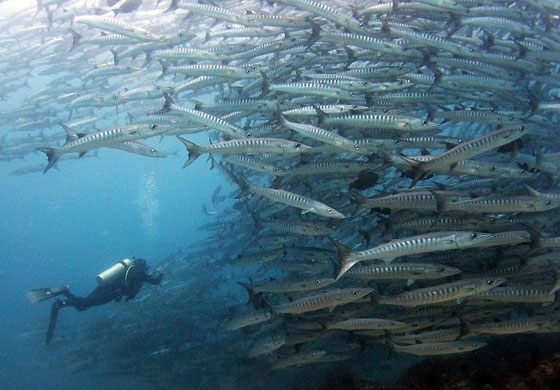
Photo: guardian.co.uk
You can dive here all year round. Overall, the best conditions at Sipadan Island exist from April to December, especially July and August. January to March can see some unsettled weather and a decrease in visibility but the resorts still see plenty of guests at this time as the diving can still be fine.
Sources: divetheworldmalaysia.com, malaysiadiving.com
Saturday, November 28, 2009
Pulau Sipadan - The jewel in the crown of diving in Malaysia
Labels: Barracuda Point, Sipadan
Posted by ThanateTan at 8:39 PM 0 comments
Wednesday, November 4, 2009
Home to the best diving and snorkeling in Thailand
The Similan Islands National Park is known for long white coral sand beaches, crystal blue waters, warm tropical nights and cooling breezes coming off the Andaman Sea. Nine Unihabited islands with some of the best scenery in Thailand. The Similan Islands are very easy to visit. Located only 50 Kilometers from Khao Lak - The Similan Islands may be visited for one day, overnight or on tours. It's now open (on November 1 each year) with a time to visit.
There are no resorts or stores on the Similans - only a couple of ranger stations and a few bungalows available for rent. The Similan Islands are home to a huge variety of marine life and incredible opportunities to see rare and endangered species. The Similan Islands are scattered with uninhabited white sandy beaches, the waters glow aqua marine blues and emerald greens, the corals are covered with many types of small marine life. The Similans offer you some of the best scuba diving in the world.
Often referred to as one of the best dive spots in the world - you will probably agree after visiting. While the underwater world may attract some people, there are also many varieties of birds and animals on the Similan islands. And of course, the long beaches! With wonderful underwater scenery and rather shallow sea level, the horseshoe-shaped island, partly encircling a small bay in the west, is suitable for skin diving to look at coral reefs and colorful fishes. In the north, large stones of different shapes and sizes are noticeable from a distance. Similan island is the largest island amoung the Similan Islands.
All reputable dive shops are affiliated with PADI or other international dive bodies, and most hold courses in multiple languages. All over Thailand, you can expect modern amenities, international standard boats and professional facilities.
For group or family travelers, all good live aboard operations will take non-divers along at a substantially reduced fee. Friends and family can relax, swim, sunbathe, snorkel and still enjoy the food, trip, scenery and experience of sailing in some of the world’s most beautiful waters.
Sources: similan-diving-safaris.com, similans.net, tourismthailand.org
Labels: Similan Diving, Similan Islands National Park
Posted by ThanateTan at 7:50 PM 0 comments
Tuesday, September 15, 2009
Clownfish (Anemonefish) – The Little Beautiful Fish in Marine
Whenever you dive I'm sure that you always meet the group of cute clownfish which enliven the underwater world. However, are you sure that you have already known them well, if you say no, let's see the following interesting info quickly.
Photo: Arne Kuilman
Clownfish and anemonefish are fishes from the subfamily Amphiprioninae in the family Pomacentridae. About twenty eight species are recognized, one in the genus Premnas, while the remaining are in the genus Amphiprion. In the wild they all form symbiotic mutualisms with sea anemones. Depending on species, clownfish are overall yellow, orange, reddish, or blackish, and many show white bars or patches and the tips of their fins have a thin black rounded stripe. The largest reach a length of 18 cm, while the smallest barely reach 10 cm. Also, they live at the bottom of the sea in sheltered reefs or in shallow lagoons, usually in pairs.
Furthermore, the unique qualification of them that made me surprised is about the reproduction. Clownfish live in small groups inhabiting a single anemone. The group consists of a breeding pair, which cohabits with a few non-reproductive, "pre-pubescent", and smaller male clownfish. When the female dies, the dominant male changes sex and becomes the female. This life history strategy is known as sequential hermaphroditism. In addition, clownfish are all born as males, they are protandrous hermaphrodites which are in contrast with another form of hermaphroditism, known as protogyny, in which all fish are born as females but can change to males later. Clownfish can lay hundreds or thousands of eggs depend on the species and they were the first type of marine ornamental fish to be successfully bred in captivity on a large scale.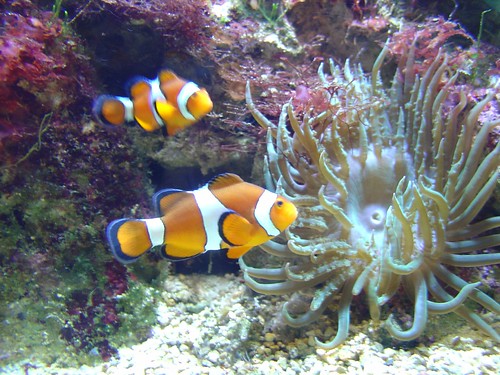
Photo: emphasis
Normally, Clownfish are not eaten by other fish and live safely at the quiet corners of the Coral reef. But, their greatest threat is human. If you don't believe me, you can see that many of them are living in the aquarium or at the rich man's home and many Coral reefs have been destroyed by human too. Moreover, Clownfish become popular for now so I'm afraid that you will not see them in the nature in the future.
Anyway, it's a good luck for them that some conservationists have found the method for helping them like raising them and their habitat. But, you can also be the part of preserving Clownfish, no need to do the great thing and spend too much money; you just begin to aware of the nature around you. Not only the aquatic animals but you can also attend to all environments in our world.
Labels: anemonefish, Clownfish, coral reef
Posted by ThanateTan at 1:46 AM 0 comments
Tuesday, September 1, 2009
Underwater Moai - Rapa Nui
On dry land our dive master turned guide and we headed off to Rano Raraku, a kind of quarry from which the original Moai were carved centuries ago. It's a strange place and the remnant of an extinct volcano. Wild horses drink in its crater lake. Dozens of Moai are scattered in the vicinity; the ones that never made it to their intended resting places. Down at 20 meters there was a surprise with underwater Moai. It was a replica, the dive master told us it was dropped down there by a local as a remembrance.
Photo: untitled-project.com
Some stand half buried, others have fallen and many more remain unfinished, part carved from the mountainside. Most are about 6-8 metres tall, though the largest is unfinished and a whopping 21 metres. No metal tools were used to create the Moai, instead they were carved using stone on stone. How the Moai came to stand at their various resting places around the island remains a mystery.
"Rapa Nui" or "Easter Island" is a Polynesian island in the southeastern Pacific Ocean, at the southeastern most point of the Polynesian triangle. A special territory of Chile annexed in 1888, Easter Island is widely famous for its monumental statues, called moai which created by the Rapanui people.
Rapa Nui is a world heritage site with much of the island protected within the Rapa Nui National Park. one of the world's most remote inhabited islands, is no less an nigma than how their descendants could design and sculpt hundred of colossal moai from hard volcanic tuff, transport these tall and heavy statues great distances from quarry to coast and erect them on great stone ahu (platforms). Residents and visitors have applied various names to this small, isolated volcanic land-mass.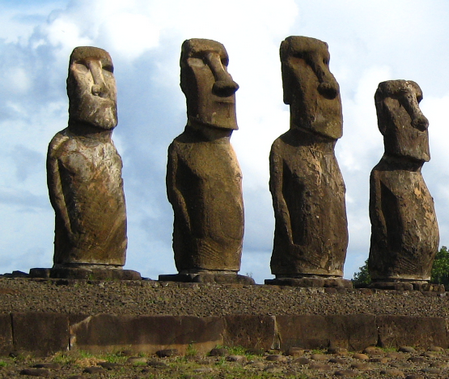
Photo: designer-daily.com
The Polynesian settlers named it Rapa Nui, but the view of the seemingly infinite sea from the summit of Terevaka, the island's highest point, reveals why they also called it Te Pito o Te Henua - the Navel or centre of the World. From Eater Island, a vessel can sail any direction with out sighting inhabited land.
Dutch mariner Jacob Roggeveen, the first European to sight the island, named it Easter Island, after the date of his discovery; the Spaniards first called it San Carlos. Other mariners dubbed it Davis's Land after confusing it with territory identified by the 17th-century English pirate Edward Davis. Roggeveen's legacy survived among Europeans. English speakers call it Easter Island. Spanish speakers refer to Isla de Pascua, Germans to Osterinsel.
A further word on terminology: What exactly to call the island in inhabitants and their language has been a topic of hairsplitting contention. It is more probable that Polynesians settled the island from the west. these peoples managed to disperse over a myriad of islands within a gigantic triangle whose apexes were at New Zealand, Hawaii and Rapa Nui, plus a handful of islands deep in Melanesia. Orthodox academic opinion currently favors an Asiatic origin for the Polynesian peoples who, apparently, built the Rapa Nui monuments.
Photo: gordonmackie.com
Details vary, but there is general agreement that migration into the Pacific region began 50,000 years ago, when ancestors of the Australian Aboriginals and New Guinea highlanders first crossed the sea in search of new homelands. some people argue that the two-word term 'Rapa Nui' is an imperial imposition that the single word 'Rapanui' more closely approximates usage in other Polynesian languages.
Source gordonmackie.com, janesoceania.com, untitled-project.com
Labels: Easter Island, Rapa Nui, Underwater Moai
Posted by ThanateTan at 3:09 PM 0 comments
Thursday, August 13, 2009
World of the Most Beautiful Tropical Paradise
Palau is a famous destination for diving. It offers some of the most unique holiday possibilities: its natural beauty, intact culture, untouched wilderness, remoteness and stability combine to offer the adventure seekers. Palau's most populous islands are Angaur, Babeldaob, Koror, and Peleliu. Palau has been described as one of the Seven Underwater Wonders of the World, with 700 species of coral and 1,200 species of identified fish.
Photo: cieer.org
The latter three lie together within the same barrier reef, while Angaur is an oceanic island several miles to the south. Palau is located between Guam, Philippines and Papua New Guinea. Palau offers an endless variety of sites to dive, from caves to walls and major dropoffs, to tunnels, channels and shallow reefs, where you can enjoy great visibiity and an almost limitless variety of marine life. Palau is rated as one of the world's best diving destinations by scuba aficionados.
There is 400 miles long archipelago, which became to be one of the world's unique phenomena "Rock Island". The coral atoll of Kayangel is situated north of these islands, while the uninhabited about 200 are situated to the west of the main island group. There are also parts of the country and make up the states of Hatohobei and Sonsorol. Imagine the whitest beaches you will ever see, gardens of coral just beneath the clearest waters, lakes filled to the brim with "sting less" jellyfish.
Explore caves, waterfalls and forests that have never been ravaged by man, and hundreds of islands of the purest beauty abound all along our pristine archipelago. These mushroom like islets are uninhabited and located in a large lagoon that has vast concentration of corals, fish and other marine life. White sand beaches, lush jungle and remote waterfalls are just among the highlights of Palau. The most amazing array of marine life you can ever imagine.
Photo: hanz.schulz
No matter your level of diving ability, there is a dive for you in Palau, fast drift dives, easy shallow dives, it's all here in Palau. It provides some of the best diving to be found in Micronesia and ideally suited for advanced divers. Explore the beauty of Palau with Scuba World Explorer Fleet. You can expect mostly wall and drift diving with visibility ranging from 60 feet to in excess of 150 feet, depending on prevailing conditions.
The tenders, however, are provided with ladders. Diving in Palau from a live aboard is better suited to those with considerable open-water experience, with the ability to maintain Perfect Buoyancy Control, and who are comfortable getting in or out of a dive tender.
Labels: Angaur, Babeldaob, Buoyancy Control, Explore cave, famous destination, Koror, Peleliu, Rock Island, sting less, World Explorer Fleet
Posted by ThanateTan at 2:29 AM 2 comments
Friday, August 7, 2009
No Tank - No Thanks, I Do Not Need A Scuba Tank.
Because I'm a freediver. I use mask, fin and wet-suit when I want to dive. Freedivers said! Freediving is any of various aquatic activities that share the practice of breath-hold underwater diving. The activity that garners the most public attention is competitive apnea, an extreme sport, in which competitors attempt to attain great depths, times or distances on a single breath without direct assistance of scuba.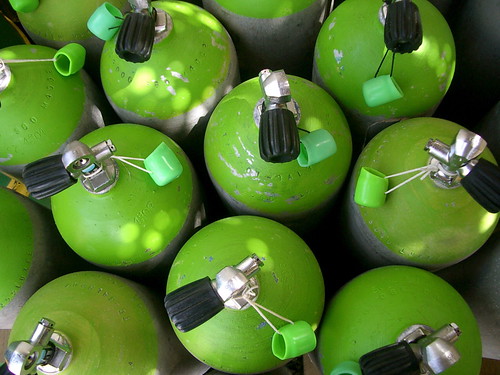
Photo: Iner
Freediving is the sport of breath hold diving in which the freediver descends under water on a single breath of air. Freediving includes leisure activities such as spearfishing and snorkelling as well as competitive disciplines: Constant Weight, Free Immersion, Variable Weight, No Limits, Dynamic and Static Apnea. Freediving is a technique used with various aquatic activities. While in general all aquatic activities that include breath-hold diving might be classified as a part of freediving, some sports are more accepted than others.
Freediving has many benefits and can be compared to a martial art. It promotes increased lung capacity, deeper levels of awareness and perception and control over your body. The discussion remains whether freediving is only a synonym for breath-hold diving or whether it describes a specific group of underwater activities. It is often strongly associated with competitive breath-hold diving or Competitive Apnea. The remainder of this article will discuss only competitive freediving as an athletic sport. Freediving is also an intriguing recreational sport, celebrated as a relaxing, liberating, and unique experience.
World Champion Freediver
In October 2007 Sara Campbell became the first woman to hit the 90m mark in freediving using only the natural propulsion of her monofin. She also scored a hat trick by setting three world records in three days, in fact in under 48 hours, ruling in all deep disciplines. And just ten days later she became World Champion in Constant Weight. Amazingly she had made her first competitive dive only seven months previously. In April 2nd 2009. Sara Campbell breaks a new woman freediving World Record in the Bahamas by diving to 96m in constant weight.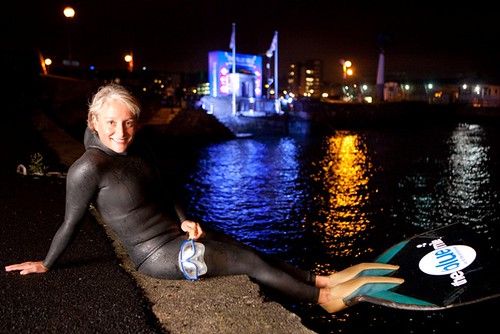
Photo: The Blue Mile Gallery
Get Start Freediving
While others may dive deeper and longer, a 45-second dive to 30 feet places you in the action. Since most of the ocean's color and animal life resides within 30 feet of the surface, there's little reason to go deeper. Forty-five seconds buys you enough time to gather game, take a photo or simply mingle as one with the fish.
Best of all, the average person can master these dives in just two weeks without spending valuable travel dollars on gear. Your essentials mask, snorkel, fins, wetsuit and weight belt-pack easily into a duffle bag. They're inexpensive yet eloquent enhancements to any aquatic vacation. You needn't be an athlete to enjoy freediving because the sport is more about mind-set, technique and correct weighting than strength.
Your goal is to join the water, rolling with the gentle sea surface, never fighting it. When you learn the basic surface dive, you'll find that it takes very little energy to slip below the surface. Relaxed and confident, you choose the depth and duration of each dive. How should you learn freediving? Not like the newlyweds I observed in Hawaii. Offering verbal support, the young man coaxed his lady into the water. Timidly she placed the unfamiliar snorkel into her mouth, flip-flopped to the reef's edge and jumped in.
Photo: e m m a
So, Freediving is about familiarity, ease, relaxation and energy conservation. To learn to freedive, find a competent, patient instructor who will guide you through the selection of your gear and who can introduce you to the basic elements of the sport in a step-wise, confidence-building fashion.
Just avoid advancing one step until you're competent with the last. Choose a comfortable mask and fins, sit by the pool's edge and become familiar with mouth-breathing through the snorkel. Step into the pool waist deep, dip your head underwater and continue breathing. Freedivers utilize two positions, horizontal and inverted, positions not usually associated with sporting activities. Advance to the horizontal by holding the pool's edge and floating face down. Breathe slowly and a little deeper to compensate for the useless "dead-space air" in your snorkel. Take a deep breath, completely submerge your head and let the snorkel fill with water. Still looking down, raise your head level with the surface and again clear the snorkel. Later, you'll learn to let a small amount of air escape into your snorkel as you ascend from a dive.
Now you're ready for the most important exercise in freediving: the "relaxed fetal position." The feelings and sensations you derive from this exercise provide your psychological base. It's the state of mind you need to recall and maintain throughout your freediving career. Breathing on the surface, simply float on your stomach, curl up into the fetal position and totally relax. Some divers come close to sleep.
Photo: mst7022
Freedivers use three fin strokes: the flutter, frog and dolphin. You'll use the flutter kick most of the time. Use the frog kick, the slower of the three, to relieve cramped and tired flutter-kick muscles. The dolphin kick is great for short bursts of speed. Make sure you use short kicks and not deep leg kicks that bend the blade more than 30 degrees. When your stroke bends the blade excessively, water spills off the side and wastes energy. Take a cue from the fish to pick up speed, use rapid small fin beats, not wide movements. The surface dive is a complex yet easily mastered maneuver. It's basic to the sport.
To get an idea of how the surface dive works, lie on your bed, belly down. Scoot over the edge until you're balanced at the waist. Now, lower one arm and raise the opposite leg. The weight shift sends you immediately down. In the water, initiate the dive by kicking forward to gain momentum. Fold your shoulders together to help you exhale deeply and spread them for a maximal inhalation.
To understand the importance of streamlining, try this test. Take a yard stick and plunge it into the water at an angle with the surface. Note the resistance. Now, place the ruler on its edge and feel how easily it slips into the water.
Sources: wikipedia.org/, britishfreediving.org/, freedive.net/, sarafreediver.com/
Labels: flip-flopped, Freediver, Freediving, surface dive
Posted by ThanateTan at 9:50 PM 1 comments
Saturday, August 1, 2009
The Dangerous Puffer Fish
Recently, I'd talk about underwater Mexico which has many puffer fishes. So, the puffers are so cute and beautiful, some people like to feed them in aquarium because they can scalable their body when scaring, it look funny in the fish tank. The Puffer fish are the second most poisonous vertebrate in the world, the first being a Golden Poison Frog. The skin and certain internal organs of many tetraodontidae are highly toxic to humans. There unique and distinctive natural defenses are a compensation for their particular form of locomotion. Puffers use a combination of pectoral, dorsal, anal, and caudal fins for propulsion that make them highly maneuverable but very slow, and therefore comparatively easy targets for predators.
As a defense mechanism, puffers have the ability to inflate rapidly, filling their extremely elastic stomachs with water or air when outside the water until they are almost spherical in shape. Thus, a hungry predator stalking the puffers may suddenly find itself facing what seems to be a much larger fish and pause, giving the puffers an opportunity to retreat to safety. When lifted out of water there is a risk that puffers inflate with air. This may result in problems deflating again afterwards.
When this happens with aquarium specimens the recommended course of action for fishkeepers is to hold the puffer underwater by the tail, head upwards, and shake the fish gently until the air escapes out of the mouth. Some puffers also produce a powerful neurotoxin called tetrodotoxin in their internal organs, making them an unpleasant, possibly lethal, meal for any predatory fish that eats one. This neurotoxin is found primarily in the ovaries and liver, although smaller amounts exist in the intestines and skin, as well as trace amounts in muscle tissue and in its blood.
The puffer's poison is made by bacteria of the genus vibrio and may actually enter the fish by consuming prey that does possess the poison already. Most puffers are drab, many have bright colors and distinctive markings and make no attempt to hide from predators. This is likely an example of aposematism. As a result, they have the smallest known genomes yet found amongst the vertebrate animals, while containing a genetic repertoire very similar to other fish and thus comparable to vertebrates generally. Puffers are able to move their eyes independently, and many species can change the color or intensity of their patterns in response to environmental changes. In these respects they are somewhat similar to the terrestrial chameleon. Since these genomes are relatively compact it is relatively fast and inexpensive to compile their complete sequences.
Photo: sushifaq.com
Puffer's toxin evolved as a response to aquatic predators such as larger fish, rather than for use against humans. Note also, not all puffers are poisonous; Takifugu oblongus, for example, is one of the fugu puffers that is not poisonous. However, it should be noted that puffer's neurotoxin is not necessarily as toxic to other animals as it is to humans, and puffers are eaten routinely by some species of fish, such as lizardfish and tiger sharks. Puffer poisoning usually results from consumption of incorrectly prepared puffer soup, chiri or occasionally from raw puffer meat, sashimi fugu. While chiri is much more likely to cause death, sashimi fugu often causes intoxication, light-headedness, and numbness of the lips, and is often eaten for this reason.
Puffer's poisoning will cause deadening of the tongue and lips, dizziness and vomiting. These are followed by numbness and prickling over the body, rapid heart rate, decreased blood pressure and muscle paralysis. Death results from suffocation as diaphragm muscles are paralyzed. Patients who live longer than 24 hours are expected to survive, although the poison can cause comas lasting several days. Many people report being fully conscious during the entirety of the coma and can often remember everything that was said while they were supposedly unconscious. So, if you diving to found them, just keep away from them.
Source: wikipedia.org
Labels: fugu, Puffer Fish
Posted by ThanateTan at 1:31 AM 0 comments
Sunday, July 19, 2009
Vacation in Mexico by Scuba Diving
If you are interested in scheduling a vacation in Mexico, or you already have, you may be wondering what you can do while on vacation. Millions of Americans schedule a Mexico vacation. In Mexico, there are an unlimited number of activities that you may find exciting. One of those activities may include scuba diving. 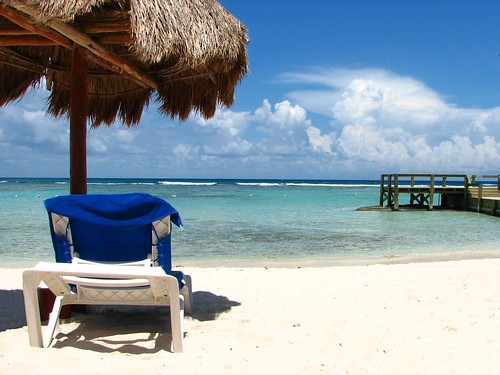
Photo: viviloob
There are many travelers who are misinformed. Many believe that you have to be an experienced diver to enjoy underwater diving in Maxico. This is simply not true. Before going scuba diving in the ocean, it is advised that you have basic knowledge of diving and strong swimming skills. However, you do not have to be an experienced diver.
When vacationing in Mexico, there are many individuals who go scuba diving for the first time. Scuba diving is a pretty self-explained activity. Scuba divers are featured in many movies and can be found in many amusement parks. While the general idea of scuba diving is the same in Mexico, what you will see underwater is not.
There are a number of underwater animals and plants that can only be seen in or around the Mexico area. This in itself is one of the many reasons why you should schedule a scuba diving adventure. In Mexico, scuba divers are often able to swim with the dolphins and sea turtles. To many, this alone is worth the cost of scuba diving. Aside from swimming with sea animals, you can also spend your scuba diving trip examining the life and environment underwater. Just a few of the many sea animals that you may see in Mexico include lobsters, eels, sting rays, and a large number of different kinds of fishes.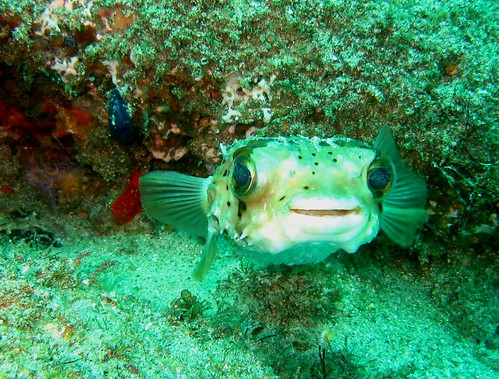
Photo: zoniedude1
The fishes found in underwater Mexico often include puffer fishes, spotted fishes, and parrot fishes. While the sea animals found underwater are the most exciting part of scuba diving, there are other underwater activities that you can participate in. Many scuba divers enjoy diving along coral reefs that are found along the coast of Mexico. Coral reefs are not only home to a large number of sea animals, but they also make for great adventures.
You may find it exciting traveling in, over, or around the many different sized reefs. Unless you are an experienced underwater diver, you are advised to go scuba diving with a trained professional. Scuba diving is a popular pastime in Mexico; therefore, you are encouraged to schedule your scuba diving adventures ahead of time. In addition to scheduling a scuba dive with a trained diver, you can learn how to scuba dive at a number of locations in Mexico. Many of these locations also offer guided tours.
Scuba diving lessons are offered as group lessons or private lessons. Private lessons may be more expensive, but many first time scuba divers find them rewarding, in more ways than one. Underworld Scuba operates scuba diving and snorkeling tours in the Manzanillo area of Mexico. It has been said that the Manzanillo area is one of the best places to go scuba diving in Mexico. Underworld Scuba, along with number other companies, state that the area is thriving with underwater life and adventures.
Photo: Mark Busse
Another popular scuba diving tour company is The Puerto Dive Team, which operates out of Oaxaco Mexico. They are most known for their private one-on-one underwater tours. To find other guided tours that are designed for scuba divers, you are encouraged to contact your local travel agent or do the research yourself.
Whether or not you have already selected your Mexico destination, you should easily be able to find nearby tours. The closer you are to the coast, the more tours you will have access to. What you can do and see underwater is absolutely amazing. It is likely what you see will stay with you for years to come.
Labels: A puffer fish, Scuba Diving in Mexico, Vacation in Mexico
Posted by ThanateTan at 9:31 AM 0 comments
Saturday, July 11, 2009
Diving Trip in St. Thomas island
St Thomas island is the most developed and popular of the U.S. Virgin Islands. It offers lots of activities to keep you busy everyday of your trip. You can fly high on an aerial tour or go under the sea scuba diving, get pampered with massages or spend the day hiking in the Virgin Islands National Park. A large number of vacationers make the decision to vacation in this island each year. St. Thomas is located in the Virgin Islands. The underwater world in the Virgin Islands is stunning and truly amazing.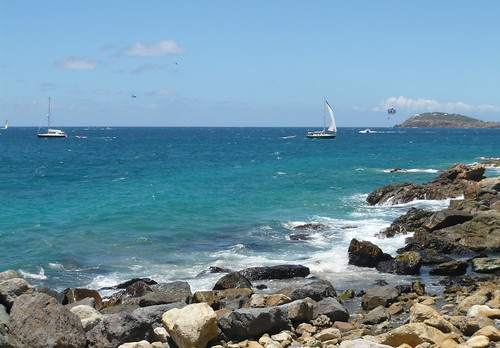
Photo: utfiero
A enticing blend of normal American life with a jaw-dropping setting leads many to choosing a St. Thomas vacation. This Caribbean island is one of the most popular summer vacation destinations in the world. Explore corals and gorgonian forest of sea fans and sea whips. Dive around caves, explore sunken boat wrecks or take a night dive and explore the fantastic world of nocturnal marine life. If you are interested in vacationing in St. Thomas, you may be wondering what fun and exciting activities await you.
You will likely find an unlined number of activities that will peak your internets. If you are looking for something that is exotic and educational all at the same time, you may want to consider scuba diving in St. Thomas. Swim among turtles, bright parrotfish, blue tangs, schools of fry and so much more. Due to its clear waters, corral reefs, and amazing sea life, St. Thomas is one of the best places in the world to go on a scuba diving adventure.
St. Thomas is well-known for its seclusion and beautiful beaches, but scuba diving is a popular underwater activity that brings in tourists from all around the world. If you are interested in scuba diving in St. Thomas, but you have never been before, you do not have to worry.
Photo: travelwizard.com
Scuba diving lessons are obtainable for individuals who want to scuba dive, but do not know how to. After a couple of lessons, you could easily be able to enjoying diving in the clear waters. Whether you consider yourself an experienced scuba diver or just a beginner, you are encouraged to scuba dive while on a guided tour. Scuba diving tours are given by trained and experienced professionals.
In addition to knowing where to look for the best underwater treasures, you will be safe. There are too many accidents that can happen in the open waters. That is why it is advised that you travel with an experienced diver and never go diving by yourself. Since it is advised that you go scuba diving with a trained professional, you will have to find a scuba diving guide or a company that offers tours.
In St. Thomas there are a number of places. When searching for scuba diving guides, you are encouraged to examine the type of tours that are available. You may find scuba diving tours right off the coast or tours that are hosted off of a boat. While searching for scuba diving tours in St. Thomas, it is likely that you will come across the Blue Island Divers. Blue Island Divers is one the most well-known and most recommended scuba diving groups in the St. Thomas area.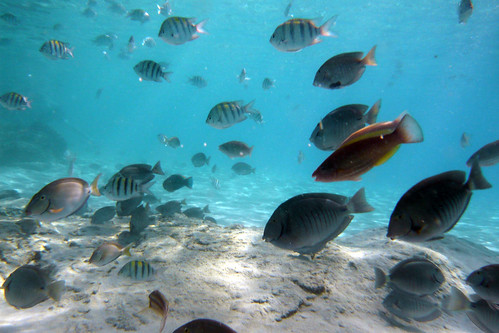
Photo: utfiero
In addition to providing their services to adults, scuba diving lessons and assistance can be given to children. Blue Island Divers offer dives that are focused on underwater wreckage and coral reefs. In addition to Blue Island Divers, it is likely that you may come across a company known as Admiralty Dive Center. The Admiralty Dive Center is a state of the art facility that offers a large number of scuba diving tours. These tours often involve exploring underwater wreckage and underwater sea life.
The best conditions for diving in the islands are found during the summer and fall months, with visibility generally between 60 and 100 feet. Some sites, particularly in Pillsbury Sound, can be explored all year round as they are protected from the wind and rough seas that can affect other more open sites during the winter months. St. Thomas and St. John are close enough to each other that they share many of the same dive sites in the Pillsbury Sound area including Carval Rock, Congo Cay, Grass Cay, Mounds at Mingo, Arches and Tunnels of Thatch and Lovango Cay.
As with the Blue Island Divers, scuba diving lessons and tours are available for individuals of all ages. As previously mentioned, there are a number of scuba diving tours that may be ideal for your next family vacation or romantic getaway. You can easily search for additional scuba diving tours by requesting a vacation brochure from the St. Thomas Island. Additional information may also be obtained through your local travel agent.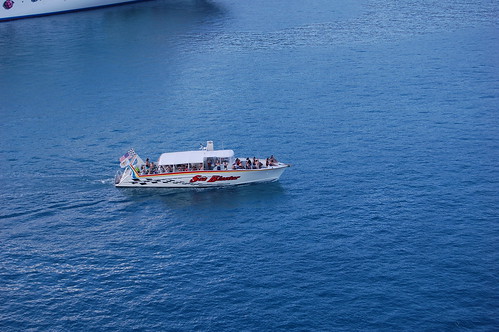
Photo: docpaula54
There are more than 40 moored dive sites around St. Thomas. Most are shallow dives and many only 15 to 20 minutes away from the shore/dock. Popular dive sites include Witchoal II, Navy Barges, Cow & Calf, Frenchman’s Cap, Ledges of Little St. James, Cartanza Senora and Buck Island Cove.
Sources: destination360.com, vinow.com
Labels: Admiralty Dive Center, Blue Island Divers, blue tangs, bright parrotfish, Carval Rock, Congo Cay, Grass Cay, Lovango Cay, Mounds at Mingo, St. Thomas island, U.S. Virgin Islands, underwater treasures
Posted by ThanateTan at 8:03 AM 0 comments
Wednesday, July 1, 2009
The Family of Seahorses and Pipefish
Did you have seen a Seahorse swimming away from you when you're diving near them? It so cute animal that I really likes. Seahorses are any species belonging to the genus Hippocampus, which, in turn, belongs to the family Syngnathidae, which also includes pipefish and leafy sea dragons. There are over 47 species of seahorse, mainly found in shallow tropical and temperate waters throughout the world. They prefer to live in sheltered areas such as sea grass beds, coral reefs, or mangroves.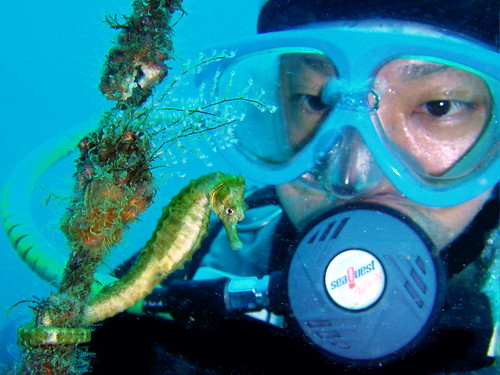
Photo: Nemo
Three different species of seahorse live in the Mediterranean Sea:
- Hippocampus hippocampus (long snout)
- Hippocampus brevirostris (short snout)
- Hippocampus fuscus (immigrated from the Red Sea)
Pipefish look like straight-bodied seahorses with tiny mouths. The name is derived from the peculiar form of their snout, which is like a long tube, ending in narrow and small mouth which opens upwards and is toothless. The body and tail are long, thin, and snake-like. They have a highly modified skeleton formed into armored plating. This dermal skeleton has several longitudinal ridges, so that a vertical section through the body looks angular, not round or oval as in the majority of other fishes.
Many Pipefish are very weak swimmers in open water, moving slowly by means of rapid movements of the dorsal fin. Some species of pipefish have tails that are prehensile as in seahorses. The majority of pipefishes have some form of a caudal fin which unlike seahorses, that can be used for locomotion.
Photo: getahugetank.com
These fish form territories, with males staying in about one square meter of their habitat while females range about one hundred times that area. They bob around in sea grass meadows, mangrove stands, and coral reefs where they are camouflaged by murky brown and grey patterns that blend into the sea grass backgrounds. During social moments or in unusual surroundings, seahorses turn bright colors.
Seahorses are rather inept swimmers and can easily die of exhaustion when caught in storm-roiled seas. They propel themselves by using a small fin on their back that flutters up to 35 times per second. Even smaller pectoral fins located near the back of the head are used for steering.
They anchor themselves with their prehensile tails to sea grasses and corals, using their elongated snouts to suck in plankton and small crustaceans that drift by. Voracious eaters, they graze continually and can consume 3,000 or more brine shrimp per day.
Photo: animals.nationalgeographic.com
Seahorses are so named for their equine profile. Although they are bony fish, they do not have scales, rather a thin skin stretched over a series of bony plates arranged in rings throughout their body. Each species has a distinct number of rings.
Seahorses swim upright, another characteristic that is not shared by their close pipefish relatives, which swim horizontally. Seahorses have a coronet on their head, which is distinct to each seahorse, much like a human fingerprint. They swim very poorly by using a dorsal fin, which they rapidly flutter to propel them, and pectoral fins, located behind their eyes, which they use to steer.
Seahorses have no caudal fin. As they are poor swimmers, they are most likely to be found resting in beds of sea grass or coral reefs, with their prehensile tails wound around a stationary object. They have long snouts, which they use to suck up food, and eyes that can move independently of each other, much like a chameleon. Seahorses eat small shrimp, tiny fish and plankton.
Photo: Felicia McCaulley
Seahorses typically mate for life. The male seahorse is equipped with a brood pouch on the ventral, or front-facing, side. When mating, the female seahorse deposits the eggs in the male's pouch, which the male then internally fertilizes. The male carries the eggs until they emerge, expelling fully-developed, miniature seahorses in the water.
Source: wikipedia.org, animals.nationalgeographic.com.
Labels: brevirostris, Hippocampus, Pipefish, Seahorses, Syngnathidae
Posted by ThanateTan at 3:26 AM 1 comments
Tuesday, June 9, 2009
Northern Red Sea - Underground Garden of Eden
The Northern Red Sea is surrounded by the world’s largest expanses of sand. It region of Eritrea is one of the country's six regions, lies along the northern three quarters of the Red Sea, and includes the Dahlak Archipelago and the coastal city of Massawa.
Photo: livetowander
The region borders the Anseba, Central and Southern regions to the west, and the Southern Red Sea region to the east. It has an area of around 27,800 km². The lowest point in Eritrea, Lake Kulul, is in this region.
The Red Sea is considered to be 1 of the 7 Wonders of the underwater world. This forms the basis of a marine eco-system which includes 1,100 species of fish, of which about 10% are endemic, the largest number of fish species in proportion to any other body of water in the world.
The Northern Red Sea has some of the richest coral in the world. In 1980, Dr. Clark wanted to make the Red Sea and its island a National Park. Ras Muhammad has sometimes called it an underwater “Garden of Eden.” The sun makes the Northern Red Sea turn different colors such as red, yellow, orange, and light green.
Photo: nationalgeographic.com
An amazing fish that lives on the in the water is the bright-red lionfish, it has a venomous dorsal spines, these fish usually swim near the bottom of the sea. They wait and trap fish in nooks and crannies.
Another creature that lives in the water is a beast they call “George” he is a Sea Monster, his head is in the shape of a beanbag chair. A humped head wrasse, he has cow lips, chameleon eyes and a body pattern in the form of an intricate green maze on a blue back round. In the red Sea there are over 1000 different kinds of tropical fish and 400 different types of coral. 30 million years ago the Red Sea was closed at its southern end and open on its northern end, it opened up into the Mediterranean Sea allowing Atlantic species to enter and breed there. About 10 million years later the earth shifted and closed the northern end and opened up the southern end. The Red Sea has fish and animals from both the Atlantic and Pacific Ocean.
The Red Sea is a fine choice for diving any time of year but the water temperatures do vary significantly. From June to August the water can reach 28°C but it falls to a chilly 20°C in February. Do plan to bring an appropriate exposure suit to suit the time of year. Therefore, you could find yourself on a coral garden atop a summit and the next a sheer wall could plunge thousands of feet into dark ocean depths. The Red Sea's abundance of marine life and depths of the reef are a thrill that many divers will tell you is unbeatable.
Sources: library.thinkquest.org, wikipedia.org, dive-the-world.com
Labels: Northern Red Sea, Underground Garden of Eden
Posted by ThanateTan at 8:17 AM 0 comments
Monday, June 1, 2009
Sea Star - The Wonderful Animal Underwater
Sea stars or "starfish" are not fish. They exhibit a superficially radial symmetry; typically have five "arms" which radiate from a central disk. However, the evolutionary ancestors of echinoderms are believed to have had bilateral symmetry. There are some 2,000 species of sea star living in all the world’s oceans, from tropical habitats to the cold seafloor.
Photo: NationalGeographic.com
Sea stars belong to a group of animals called echinoderms, which means "spiny skin." They are related to brittle stars, sea urchins, sea cucumbers, and sand dollars. Sea stars have five arms, or rays, connected to a small round body.
Sea stars detect light with five purple eyespots at the end of each arm. Beyond their distinctive shape, sea stars are famous for their ability to regenerate limbs, and in some cases, entire bodies. They accomplish this by housing most or all of their vital organs in their arms. Some require the central body to be intact to regenerate, but a few species can grow an entirely new sea star just from a portion of a severed limb. The bright orange dot in the center of the body is called the madreporite. This organ pumps water into the sea star's body. This pumping action creates suction at the end of hundreds of tube feet, located in paired rows on the underside of the arms. They do exhibit some superficial remnant of this body structure, evident in their larval pluteus forms.
They wrap their bodies around quahogs and other bivalves, using the suction from their tube feet to pull shells apart. When the prey is opened, the sea star pushes its stomach out of its body and into the bivalve, secreting enzymes that digest the prey's soft body tissues. The liquefied bivalve is then absorbed into the stomach. Sea stars feed often, and their size depends on the amount of food they eat, not on their age.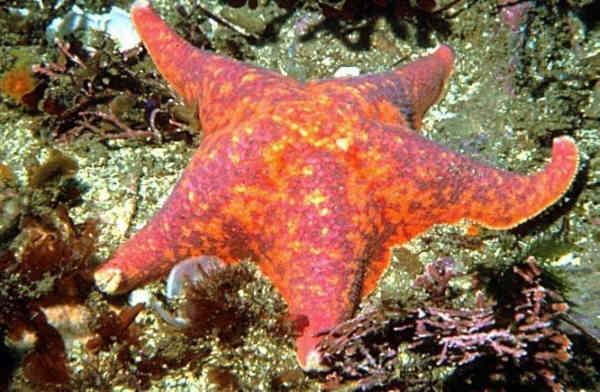
Photo: msnucleus.org
Sea stars do not rely on a jointed, movable skeleton for support and locomotion, but instead possess a hydraulic water vascular system that aids in locomotion. The water vascular system has many projections called tube feet on the ventral face of the sea star's arms which function in locomotion and aid with feeding. Sea stars usually hunt for shelled animals such as oysters and clams. They have two stomachs. One stomach is used for digestion, and the second stomach can be extended outward to engulf and digest prey. This feature allows the sea star to hunt prey that is much larger than its mouth would otherwise allow. Sea stars are able to regenerate lost arms.
A new sea star may be regenerated from a single arm attached to a portion of the central disk. Sea stars are eaten by bottom-dwelling fish and crabs, as well as by sea gulls when low tides leave the sea stars exposed. Regeneration will occur as long as one fifth of the sea star's body remains intact. Sea stars breed in the spring, producing as many as 2,500,000 eggs. Females will feel plump and spongy when their arms are filled with eggs.
Sea star digestion is carried out in two stomachs in the mouth: the cardiac stomach and the pyloric stomach. The cardiac stomach is a sack like stomach located at the center of the body and may be everted out of the organism's body to engulf and digest food. Some species are able to use their water vascular systems to force open the shells of bivalve mollusks such as clams and mussels by injecting their stomachs into the shells.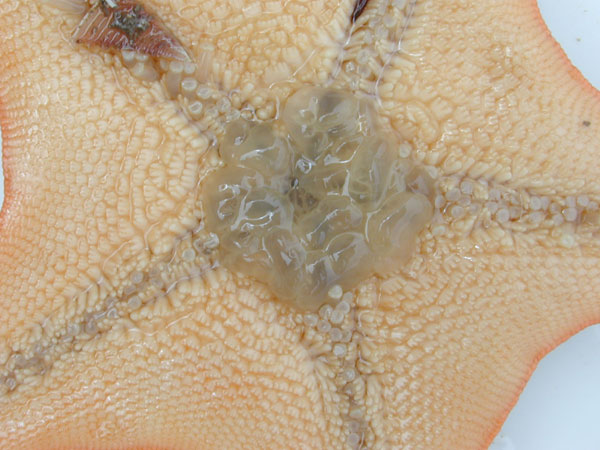
Photo: marinebio.net
With the stomach inserted inside the shell, the sea star is able to digest the mollusk in place. Most sea stars also have the remarkable ability to consume prey outside their bodies. Using tiny, suction-cupped tube feet, they pry open clams or oysters, and their sack-like cardiac stomach emerges from their mouth and oozes inside the shell. The stomach then envelops the prey to digest it, and finally withdraws back into the body.
Sources: edc.uri.edu, nationalgeographic.com, wikipedia.org
Labels: Sea Star, spiny skin, Starfish
Posted by ThanateTan at 8:11 AM 0 comments
Sunday, May 24, 2009
Diving Suit for Scuba Diving
Diving Suit or Wetsuit is an important in scuba diving as an air tank. There is a thin layer of water that is allowed to get between the suit and the skin of the diver. The skin of the diver will warm the water. It is an essential piece of scuba gear. Choosing the appropriate wetsuit, however, depends upon many factors and preferences. When immersed in a body of water, the human body loses stored heat 20 times faster compared to the standard conductivity rates on land. In this regard, the wetsuit has been designed to minimize the loss of body heat by trapping energy between the scuba gear's material and the pores of your skin during the dive in Underwater.
Photo: wwarby
Water conducts heat away from the body approximately 25 times more efficiently than air, so an unprotected individual can succumb to hypothermia even in warm water on a warm day. Wetsuits are made out of closed cell, foam neoprene, a synthetic rubber that contains small bubbles of nitrogen gas when made for use as wetsuit material. Nitrogen gas has very low thermal conductivity, so it reduces heat from the body from being lost to the water outside of the wetsuit.
The wetsuit benefits are not without controversy though, as those who utilize a suit in open water swimming events and triathlons believe that they enjoy a competitive advantage over those not wearing a suit. It is believed that a wetsuit benefits the wearer in terms of buoyancy and hydrodynamic curve, the later term basically meaning that the individual gets a distinct advantage from the more streamlined effect, as well as additional water forces aiding the wearer. In some triathlons the competitors are not allowed to wear a wetsuit and one should inquire as to whether this is allowed or not prior to entry in such a triathlon, as this may result in disqualification from winning any prizes in the competition.
Wetsuits come in different thicknesses depending on the conditions for which it is intended. The thicker the suit, the warmer it will keep the wearer. Because wetsuits offer significant protection from jellyfish, coral and other hazards, many divers opt to wear a thin suit which provides minimal insulation (often called a "bodysuit") even when the water is warm enough to comfortably forego insulating garments. A thick suit is stiff, so mobility is restricted; at a certain thickness the suit would become impractical, which is why drysuits must be worn in particularly cold environments. A wetsuit is normally described in terms of its thickness. For instance, a wetsuit with a torso thickness of 5 mm and a limb thickness of 3 mm will be described as a "5/3". With new technologies the neoprene is getting more flexible. Modern 4/3 wetsuits, for instance, may feel as flexible as a 3/2 of only a few years ago. Some suits have extra layers added for key areas such as the lower back.
Photo: vikingdiveroh
Different shapes of wetsuit are available, in order of coverage:
- A sleeveless vest, covering only the torso, provides minimal coverage. Some include an attached hood. These are not intended to be worn alone, but rather as an extra layer over or under a longer wetsuit.
- A jacket covers the torso and arms, with little to no coverage for the legs. Some jackets have short leg sleeves like a shorty, others feature leg holes similar to a women's swimsuit. A third style, the beavertail, which was quite popular until the 1980s, had a flap which closed over the crotch and attached at the front with a fastener.
- A shorty or spring suit covers the torso and has short sleeves for the arms and legs. There are also forms of spring suits with long arms and short legs.
- A long john or farmer john/jane (depending on the gender the suit is designed for) covers the torso and legs only; it resembles a bib-and-brace overall, hence the nickname.
- A full suit or steamer covers the torso and the full length of the arms and legs.
- A legless wetsuit is available, although rare. They consist of long sleeves or none at all and no legs so the suit covers the crotch and most of the buttocks.
Usually they have no feet or hood, and the diver must wear separate booties and hood made from wetsuit material. Using hoods: in the thermal balance of the human body, the heat loss over the head is at least 20% of the whole balance. Thus, for the sake of thermal protection of the diver, wearing a well-fitting hood is good practice, even at fairly moderate water temperatures.
A specialized kind of wetsuit, with a very smooth and somewhat delicate outer surface is used for long distance swimming and triathlon. These are designed to maximize the mobility of the limbs while providing both warmth and buoyancy.
Heated wetsuits also being tested and will soon be available on the market. These suits have special heating panels integrated in the back of the wetsuit. The power for heating comes from batteries also integrated into the wetsuit. Smaller Wetsuits are even made for children in many sizes, types, and thicknesses.

U.S. Divers Mercury Full Adult Wetsuit
Find a fine wetsuit by comparison, The Mercury is just as good as any of other brands. This U.S. Divers' Mercury wetsuit made of the highest quality materials available offers a superior combination of fit, performance and style. The full size suit is distinguished by its titanium blend 3 mm chest panels, which reflect heat back to the body to keep divers and surfers warm in frigid conditions and the 2 mm side panels, which are pliable enough for upper body twists.
The suit also features a super-stretch panel under each arm for added flexibility. And thanks to the neoskin seals on the neck, legs, and wrists, the suit seals out water with aplomb. Other details include flat-lock stitching for extra comfort, a pull chord with a double tap hook and loop tie down to keep the suit fully sealed, and anti abrasion knee pads to minimize rubbing and scraping. Available in a variety of sizes, the Mercury suit is backed by a two year limited warranty.
Source: wikipedia.org, babywetsuits.com
Labels: body suit, Diving Suit, swimsuit, wetsuit
Posted by ThanateTan at 7:07 PM 0 comments
Tuesday, May 19, 2009
Scuba Diving To Explore
Engorging, miraculous, blue waters of the ocean are so enticing to any person that enjoys water. Imagine spending an entire week underwater exploring the known and unknown creatures that bring your attention to a striking halt of exasperation. Eyes wide open and heartbeat just rest in every dwelling "in awe" moment. The underwater world is glorifying to anyone that takes the challenge of scuba diving. This is where life and reality meet.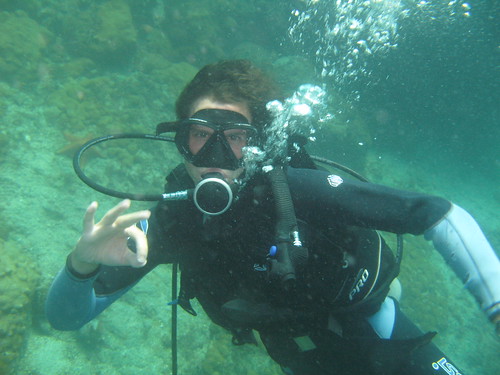
Photo: Breax201
You have all your gear in check, and you are already on the boat riding to your drop off destination, somewhere in the middle of the ocean. Tropical waters provide you with warm temperatures and bright, bold, intriguing colors. You are now waiting for the "OK" signal to splash into the everlasting pool of water. "Splash" and you are ready for the float of your life. Open your eyes to a wonder world of fish, coral reefs, seaweed, sharks, dolphins, and those creatures that are invisible to the naked eye. This is the underworld, so amazing it cannot be explained; only experienced. If you have not taken the opportunity to scuba dive, find a way, because this is our world and every part should be discovered.
Browsing through the rocky coral reefs, you see creatures that blend in to their surroundings. You have to look closer to be sure they are creatures and not part of the beautiful scenery. The creatures can look like seaweed, rocks, coral, and even other fish. Pink, blue, green, turquoise, yellow, orange, red, purple, grey, and black are just some of the most beautiful colors you will see in the most exuberance presentation known. How would you discover such amazing creatures and colors if you never took the chance to go scuba diving? It is only through scuba diving that you will learn and become the next adventurer into the underworld.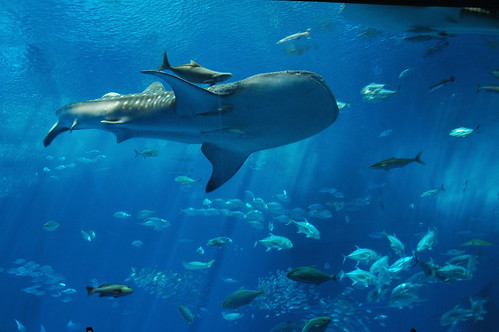
Photo: Yoshiko314
Scuba diving gives you the experience of a lifetime. What if you ran into a group of dolphins or whales on your sea voyage? What would your reaction be? Perhaps you would hitch a ride on the back of a gentle spirited dolphin, or you would just watch in amazement as that pod of killer whales jump out of the waters doing marvelous acrobats? Killer whales are amongst the most extraordinaire creatures to follow and learn about. Their behavior has been scientifically proven to match that of the human. Scuba diving would give a person the once in a lifetime chance to swim with these beautiful whales and watch as they perform in their natural environment.
You near your scuba diving journey's end although the trip could last forever. But the air tanks must be refilled and your body must recover from all the day's work. As you climb aboard the boat, you look back into the water for one last look. A dolphin splashes in the distance, almost as if to say "goodbye and thanks for visiting my home". You are now back into the human world of fresh air and salty sea spray on your face as you take off towards the beach.
This is a full article which published at ezinearticles, if your want to read more articles please visit Thanate Tan page.
Labels: Diving To Explore, exasperation
Posted by ThanateTan at 6:07 AM 2 comments
Tuesday, April 21, 2009
The Great Blue Hole of Belize Barrier Reef
The Belize Barrier Reef is the longest barrier reef in the Western Hemisphere and the second longest in the world. It is a series of coral reefs straddling the coast of Belize, roughly 300 meters offshore in the north and 40 kilometers in the south within the country limits. The Belize Barrier Reef is a 300 kilometers long section of the 900 kilometers long Mesoamerican Barrier Reef System, which is continuous from Cancún on the northeast tip of the Yucatán Peninsula through the Riviera Maya up to offshore Guatemala, making it the second largest coral reef system in the world after the Great Barrier Reef in Australia, popular for scuba diving and snorkeling. It is Belize's top tourist destination, attracting almost half of its 260,000 visitors, and vital to its fishing industry.
The three Belize atoll reefs are formed on two tiers of submarine ridges: Turneffe and Glover's on one ridge and Lighthouse on a separate ridge farther to the east. This accounts for their similar outlines and NE-SW orientations. Deep marine trenches separate the two ridges.
Inside the reef the water is shallow, with a blue tinge; outside the reef the water is deep and from the air shows a dark royal blue. On very clear days the reef appears as a narrow yellow line dividing the two shades of blue. Only near Ambergris Caye does the reef run so close to a well-populated caye. Here it is an almost so!id wall of magnificent coral formation broken only by narrow channels called "quebradas". Here an observant diver can be kept entertained for hours on end by the unending variety, shapes and colours ofthe tropical coral.
But the reef is more than just a decorative sideshow. Without it the island would not exist for it serves as a natural break-water protecting the beach from erosion by the waves, and sheltering the caye and its inhabitants. The remarkably clear and shallow water inside the reef allows excellent viewing of the fabulous marine life of the area. Rainbow tinged tropical fish, delicate sea fans and majestic coral gardens abound. Outside the reef, the seabed drops sharply in a series of plateau to depths of thousands of feet. Out here in the blue are found the gamefish - mackerel, kingfish, wahoo, tuna, sailfish and marlin.
The Great Blue Hole
The Great Blue Hole is a large underwater sinkhole off the coast of Belize. It lies near the center of Lighthouse Reef, a small atoll 100 kilometres (62 mi) from the mainland and Belize City. The hole is circular in shape, over 300 metres (984 ft) across and 125 metres (410 ft) deep. It was formed as a limestone cave system during the last glacial period when sea levels were much lower. As the ocean began to rise again, the caves flooded, and the roof collapsed. Believed to be the world’s largest feature of its kind, the Great Blue Hole is part of the larger Belize Barrier Reef Reserve System, a World Heritage site of the United Nations Educational, Scientific and Cultural Organization (UNESCO).
This is a popular spot amongst recreational scuba divers, who are lured by the opportunity to dive in crystal clear water and meet several species of fish, including giant groupers, nurse sharks and several types of reef sharks such as the Caribbean reef shark and the Blacktip shark. Other species of sharks, like the bull shark and hammerheads, have been reported there, but are not regular sightings. Usually, dive trips to the Great Blue Hole are full-day trips, which include one dive in the Blue Hole and two further dives in nearby reefs.
The temperature in the Blue Hole at 130ft is about 76F with hardly any change throughout the year at that depth. For all the practical purposes the over 400-foot depth makes the Blue Hole a bottomless pit. The walls are sheer from the surface until a depth of approximately 110 feet where you will begin to encounter stalactite formtions which actually angle back, allowing you to dive underneath monstrous overhangs.
Hovering amongst the stalactites, you can't help but feel humbled by the knowledge that the massive formation before you once stood high and dry above the surface of the sea eons ago. The feeling is enhanced by the dizzying effect of nitrogen breathed at depths. The water is motionless and the visibility often approaches 200 feet as you break a very noticeable thermocline.
Sources: bushtracks.com, wikipedia.org, ambergriscaye.com, ambergriscaye.com, wondersofbelize.com, latimes.com
Labels: Belize Barrier Reef, The Great Blue Hole
Posted by ThanateTan at 1:56 AM 3 comments
Tuesday, April 14, 2009
The Fascinating Life Underwater
The life that evolved underwater has been of constant interest for people from all times and places. The rivers, lakes seas and oceans have been always been regarded with deep interest and profound admiration by the human race, unable to decipher the secrets carefully hidden by them.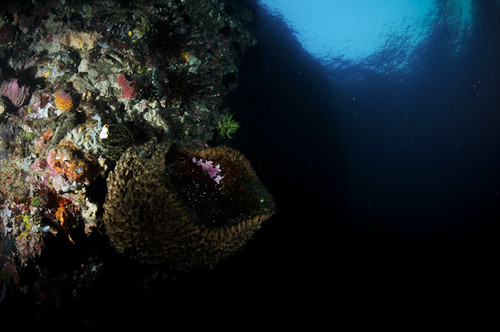
Photo: -Pinneng-
Yet, the development of the technology has provided men with proper means of unveiling some of the mysteries from underwater. With the help of waterproof cameras and appropriate technical equipment, the specialists have started the conquest of the most attractive and at the same time the most dangerous environment: the underwater.
Photographs about the fascinating life from underwater have appeared and are available to all the people who are curious to see what kinds of animals live deep in the seas and oceans of the world. The pictures, showing animals, plants and even landscape from the underworld are considered by the passionate to be much more spectacular than any picture taken on the ground or in air.
However, the beauty of the underwater was not the only thing that was exploited with the help of the new technology. The seas and oceans were discovered to be important sources of oil and gas, as well as other kinds of veins that have brought fortunes to the companies that have exploited them.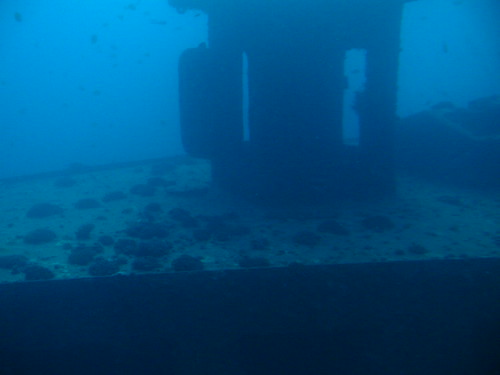
Photo: RuthannOC
But the unexpected of the underwater does not end here. The numerous ships that have sunk in the murky waters have become the favorite attraction for the archeologists and specialists in shipwrecks. Even normal people have developed a special passion for the shipwrecks found on the bottom of the seas and oceans. The fascination is even bigger when the remaining of the boats has been covered with specific vegetation and the animals have invaded it.
Other spectacular things that can be found underwater are the ruins of the towns and villages that have been covered by water. The historians have found on the bottom of the seas and oceans traces of ancient civilizations. Their uniqueness has fascinated scientists and the public opinion at the same time.
As it can easily be seen there are a lot of interesting and surprising things to be seen underwater. An advantage of the present days is the fact that now these beautiful things are available not only to the specialist, but also to men, women and even children from all around the world. The courses of scuba-diving have precisely this purpose, of showing to the normal people the wonderful life and landscape hidden underwater. This kind of activity has become very popular nowadays, as the images seen in the water cannot be described in words.
This part of world that is so carefully protected by water is probably one of the most beautiful and spectacular ones. Its inaccessibility and its beauty make the underwater life a world that worth being appreciated, admired and protected.
This Article also published at ezineArticles. Please feel free to read more story.
Labels: Fascinating Life, Life Underwater Mystery Underwater
Posted by ThanateTan at 8:36 AM 0 comments
Thursday, March 19, 2009
Bioluminescent Under the Arctic Abyss
Bioluminescence is the production and emission of light by a living organism as the result of a chemical reaction during which chemical energy is converted to light energy. Its name is a hybrid word, originating from the Greek bios for "living" and the Latin lumen "light". Adenosine triphosphate is involved in most instances.
Photo: rci.rutgers.edu
The chemical reaction can occur either inside or outside the cell. In bacteria, the expression of genes related to bioluminescence is controlled by an operon called the Lux operon. Bioluminescence has appeared independently several times during evolution.
Bioluminescence occurs in marine vertebrates and invertebrates, as well as microorganisms and terrestrial animals. Symbiotic organisms carried within larger organisms are also known to bioluminesce.
Some of Bioluminescent creatures give off light continually. Others flash their lights on and off by mixing their chemicals on queue or by covering their light organs with a flap of skin. The flashlight fish has a light-producing organ near its eyes that is covered with an eyelid-type flap. The fish can flash its light by opening and closing this flap. These creatures produce light for a variety of reasons. For some, it is a warning to stay away. For others, it is a form of camouflage. Certain species of shallow water squid give off light to blend in with the moonlight. Some creatures use their light for navigation.
Certain fish species use bioluminescence as a form of "night light". Some use it for communication. Certain species of crustaceans send out coded signals to others of their own kind during mating season. Other creatures use bioluminescence as a trap. The anglerfish uses a lighted "lure" on the top of its head to attract its prey. When the unsuspecting animal is within striking distance, the angler vacuums it down with a lightening-fast snap of its powerful jaws. Whatever the reason for producing this dazzling light show, it remains as one of the natural world's most bizarre and spectacular facts.
Sources: wikipedia.org, seasky.org
Labels: Arctic Abyss, Bioluminescent
Posted by ThanateTan at 9:49 PM 0 comments
Saturday, March 14, 2009
Lake Baikal - The Pearl of Siberia
The border between Siberian Russia and Mongolia is a natural divide here, with rugged hills and mountains forming series of wrinkles between the sprawling Russian forests to the north and rolling grasslands to the south. About midway along this border, in a gigantic stone bowl nearly four hundred miles (636 km) long and almost fifty miles (80 km) wide, lies almost one quarter of the all the fresh water on earth--Lake Baikal.
At 1,637 meters (5,370 ft), Lake Baikal is the deepest lake in the world and the largest freshwater lake in the world by volume. However, Lake Baikal contains less than one third the amount of water as the Caspian Sea, which is the largest lake in the world. Like Lake Tanganyika, Lake Baikal was formed in an ancient rift valley and therefore, is long and crescent-shaped with a surface area (31,494 km2/12,160 sq mi), less than that of Lake Superior or Lake Victoria. Baikal is home to more than 1,700 species of plants and animals, two thirds of which can be found nowhere else in the world and was declared a UNESCO World Heritage Site in 1996. At more than 25 million years old, it is the oldest lake in the world.
A Russian mini-submarine attempting to set a record for the deepest freshwater dive on July 29, 2008, was originally reported as being successful, but a correction later emerged that reported the MIR I failed to do so, reaching a depth of only 1,580 meters (5,200 ft).
The Committee inscribed Lake Baikal as the most outstanding example of a freshwater ecosystem on the basis of natrual criteria (vii), (viii), (ix) and (x). It is the oldest and deepest of the world´s lakes containing nearly 20% of the world´s unfrozen freshwater reserve. The lake contains an outstanding variety of endemic flora and fauna, which is of exceptional value to evolutionary science. It is also surrounded by a system of protected areas that have high scenic and other natural values. The Committee took note of the confirmation of the revised boundaries of the site, which correspond to the core areas defined in the Baikal Law (excluding the five urban developed areas). It also noted that the special Lake Baikal Law is now in its second reading in the Duma. Finally, it noted concern over a number of integrity issues including pollution, which should be brought to the attention of the Russian authorities.
The nerpa, or Lake Baikal seal
Lake Baikal long ago became famous for the purity of its waters and surrounding shores, a pristine state that had been seriously threatened by planned industrial development in recent years. Luckily, Baikal was one of the first regions to benefit from the new Russian government's reversal of decades of anti-environmental industrial policies. Since 1992 Lake Baikal and the entire surrounding area have been designated as a national park, and Baikal is today a naturalist's paradise and an idyllic holiday destination. With fine beaches, excellent hiking, birdwatching, and pleasure boating, Baikal is well-positioned to become one of the most attractive vacation spots in Asia.
The Baikal basin, enormous in extent and depth, from the morphological viewpoint, represents a junction of three original troughs, more deeper South and Middle troughs and relatively shallow North trough. The troughs are divided by a prominent elevations of the bottom, the intradepressional uplifts.
The scientists indicate that unlike southern Baikal, where there is no connection between land and underwater reliefs, the most of underwater structures of North Baikal in western and eastern coast are distinctly of superficial origin. They held their shape under water. The latest bathymetric data show that the Baikal basin is cut by a continuous elevation of the bottom from the Olkhon island through the Ushkany islands and farther to the northeast. This is the Academic ridge.
In 1977 the Limnological Institute together with the Institute of Oceanology, USSR Academy of Sciences, carried out deep-sea visual studies of underwater relief, using the "Pisces" an apparatus of autonomous plunge and underwater sailing. In southern trough of the lake 42 submersions were carried out, among them 5 to the depth of more than 1000 m. At this period the record depth of submersion of a man in fresh reservoirs, 1410 m, was reached.
Sources: wikipedia.org, geographia.com, bww.irk.ru,
ucpress.edu, rian.ru
Labels: Lake Baikal, The nerpa, World Heritage Site
Posted by ThanateTan at 12:01 AM 0 comments
Tuesday, March 3, 2009
The Photochromic of the sea - Cuttlefish
Cuttlefish is the Underwater animal which the same class with squid, octopuses and nautiluses. Despite their common name, cuttlefish are not fish but molluscs. Recent studies indicate that cuttlefish are among the most intelligent invertebrate species.
They have an internal shell, large W-shaped pupils, eight arms and two tentacles furnished with denticulated suckers, with which they secure their prey.
Cuttlefish eat small molluscs, crabs, shrimp, fish and other cuttlefish. Their predators include dolphins, sharks, fish, seals and other cuttlefish. Their life expectancy is about one to two years.
Photochromic
Cuttlefish are photochromic and are sometimes referred to as the chameleon of the sea because of their remarkable ability to rapidly alter their skin color at will. Their skin flashes a fast-changing pattern as communication to other cuttlefish and to camouflage them from predators. This color-changing function is produced by groups of red, yellow, brown, and black pigmented chromatophores above a layer of reflective iridophores and leucophores, with up to 200 of these specialized pigment cells per square millimeter.
The pigmented chromatophores have a sac of pigment and a large membrane that is folded when retracted. There are 6-20 small muscle cells on the sides which can contract to squash the elastic sac into a disc against the skin. Yellow chromatophores (xanthophores) are closest to the surface of the skin, red and orange are below (erythrophores), and brown or black are just above the iridophore layer (melanophores). The iridophores reflect blue and green light.
Iridophores are plates of chitin or protein, which can reflect the environment around a cuttlefish. They are responsible for the metallic blues, greens, golds, and silvers often seen on cuttlefish. All of these cells can be used in combinations. For example, orange is produced by red and yellow chromatophores, while purple can be created by a red chromatophore and an iridophore.
The cuttlefish can also use an iridophore and a yellow chromatophore to produce a brighter green. As well as being able to influence the color of the light that reflects off their skin, cuttlefish can also affect the light's polarization, which can be used to signal to other marine animals, many of which can also sense polarization.
Labels: Attack SCUBA diver, Cuttlefish, Giant Cuttlefish, Photochromic
Posted by ThanateTan at 6:08 AM 0 comments
Wednesday, February 25, 2009
Scuba diving for Underwater
The Scuba was designed for use with Underwater, because a human like us cannot stay with a few times in Underwater. So many diver created and developed the Scuba accessories for use in the place that they want to explore.
The scuba meaning from Wikipedia show below;
SCUBA (Self Contained Underwater Breathing Apparatus) diving is swimming underwater, or taking part in another activity, while using a scuba set. By carrying a source of breathing gas, the scuba diver is able to stay underwater longer than with the simple breath-holding techniques used in snorkeling and free-diving, and is not hindered by air lines to a remote air source. The scuba diver typically swims underwater by using fins attached to the feet. However, some divers also move around with the assistance of a DPV, commonly called a "scooter", or by using surface-tethered devices called sleds pulled by a boat.Scuba diving is still evolving, but general classifications have grown to describe various diving activities. These classifications include:
• Commercial diving
• Military diving
• Naval diving
• Police diving
• Professional diving
• Recreational diving
• Rescue and recovery diving
• Scientific diving
• Technical diving
o Cave diving
o Cavern diving
o Deep diving
o Ice diving
o Wreck diving
Moreover if you want to explore or going down the Underwater, you must have Scuba certificate. Scuba diving requires certification, which can be done through a number of scuba diving agencies, including SSI, NAUI and PADI. Scuba certification agencies are all basically the same in everywhere around the world. You also need this license for hiring the scuba options from scuba shop.
Labels: Scuba diving
Posted by ThanateTan at 5:25 AM 0 comments
Monday, February 16, 2009
Underwater Flash
Wide-angle image of French angelfish with proper balance between flash and sunlight
The use of a flash or strobe is often regarded as the most difficult aspect of underwater photography. Some common misconceptions exist about the proper use of flash underwater, especially as it relates to wide-angle photography.
Generally, the flash should be used to supplement the overall exposure and restore lost color, not as the primary light source. In situations such as the interior of caves or shipwrecks, wide-angle images can be 100% strobe light, but such situations are fairly rare. Usually, the photographer tries to create an aesthetic balance between the available sunlight and the strobe. Deep, dark or low visibility environments can make this balance more difficult, but the concept remains the same. Many modern cameras have simplified this process through various automatic exposure modes and the use of through-the-lens (TTL) metering. The increasing use of digital cameras has reduced the learning curve of underwater flash significantly, since the user can instantly review photos and make adjustments.
Color is absorbed as it travels through water, so that the deeper you are, the less reds, oranges and yellow colors remain. The strobe replaces that color. It also helps to provide shadow and texture, and is a valuable tool for creativitiy.
An added complication is the phenomenon of backscatter, where the flash reflects off particles or plankton in the water. Even seemingly clear water contains enormous amounts of this particulate, even if it is not readily seen by the naked eye. The best technique for avoiding backscatter is positioning the strobe away from the primary plane of the camera. Ideally, this means the flash will not light up the water directly in front of the lens, but will still strike the subject. Various systems of jointed arms and attachments are used to make off-camera strobes easier to manipulate.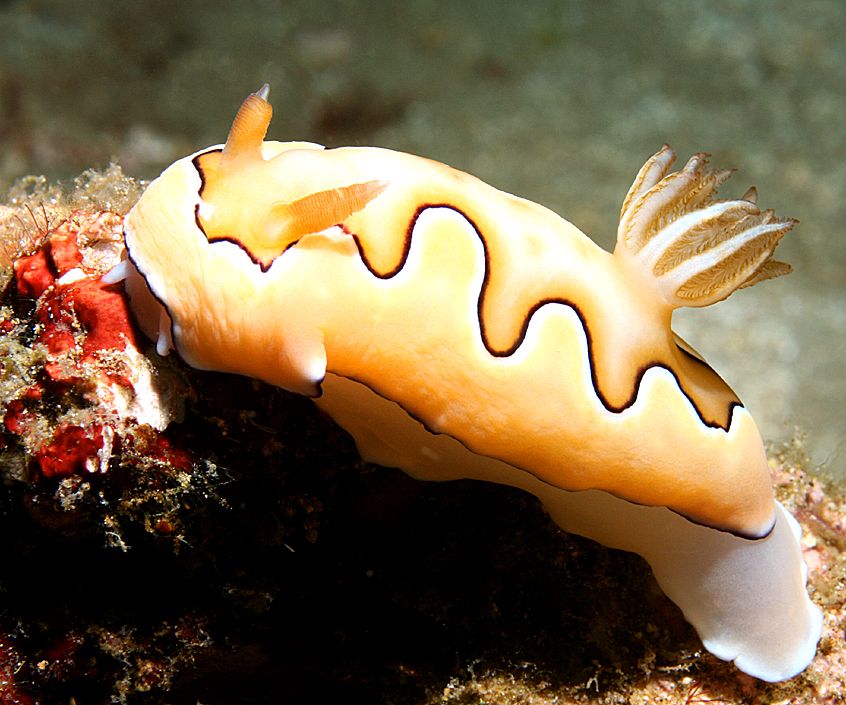
Photo: richard-seaman.com
When using macro lenses, photographers are much more likely to use 100% strobe light for the exposure. The subject is normally very close to the lens, and the available sunlight is usually not sufficient. There have been some attempts to avoid the use of flash entirely, but these have mostly failed. In shallow water, the use of custom white-balance provides excellent color without the use of strobe.
In theory one could use color filters to overcome the blue-green shift, but this can be problematic. The amount of shift would vary with depth and turbidity, and there would still be a significant loss of contrast. Many digital cameras have settings that will provide color correction, but this can cause other problems. For example, an image shifted toward the "warm" part of the spectrum can create background water which appears gray, purple or pink, and looks very unnatural.
There have been some successful experiments using filters combined with the RAW image format function on some high-end digital cameras, allowing much more detailed manipulation in the digital darkroom. This approach will probably always be restricted to shallow to moderate depths, where the loss of color is less extreme. In spite of that, it can be very effective for large subjects such as shipwrecks which could not be lit effectively with any strobe. Natural light photography underwater can be beautiful when done properly with subjects such as upward silhouettes, light beams, and large subjects such as whales and dolphins.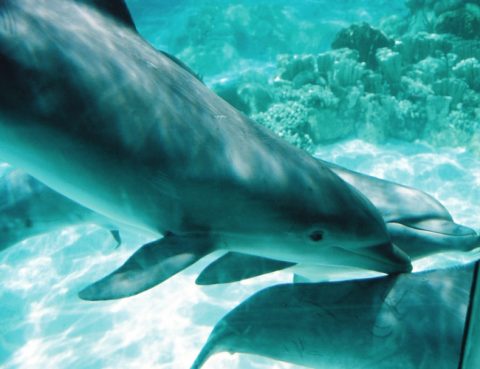
Photo: hitech-dolphin.com
Although digital cameras have revolutionized many aspects of underwater imaging, it is unlikely that flash will ever be eliminated completely. From an aesthetic standpoint, the flash often adds "pop" and helps to highlight the subject. Ultimately the loss of color and contrast is a pervasive optical problem that cannot always be adjusted in software such as Photoshop.
Labels: Underwater Flash
Posted by ThanateTan at 5:38 PM 0 comments


